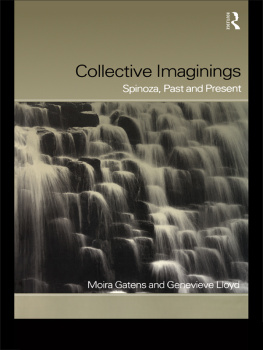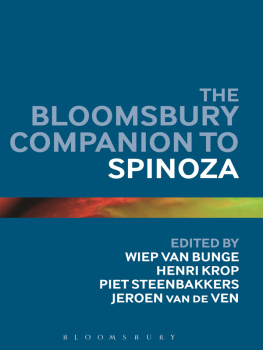Collective Imaginings
Collective Imaginings shows us how the work of the seventeenth-century philosopher Benedict de Spinoza is still relevant today. Gatens and Lloyd discuss Spinozas work from the perspective of a concern with contemporary issues of freedom, responsibility and the understanding of difference.
In re-emphasising the continuities between Spinozas philosophy and its Stoic sources, this book offers ways of re-thinking contemporary attitudes towards community and difference, freedom and necessity, reason and imagination. We see that what emerges is a concept of responsibility centred less on what we, as individuals, have done than on what we collectively are.
This ground-breaking study will be invaluable reading to students and academics wishing to gain a fresh perspective on Spinozas thought.
Moira Gatens teaches Philosophy at the University of Sydney. She is the author of Imaginary Bodies and Feminism and Philosophy.Genevieve Lloyd is Professor of Philosophy at the University of New South Wales. She is the author of The Man of Reason, Being in Time, Part of Nature, and Routledge Philosophy Guide to Spinoza and the Ethics.
Collective Imaginings
Spinoza, past and present
Moira Gatens and Genevieve Lloyd
First published 1999 by Routledge
11 New Fetter Lane, London EC4P 4EE
Simultaneously published in the USA and Canada
by Routledge
29 West 35th Street, New York, NY 10001
Routledge is an imprint of the Taylor & Francis Group
This edition published in the Taylor & Francis e-Library, 2002.
1999 Moira Gatens and Genevieve Lloyd
All rights reserved. No part of this book may be reprinted or reproduced or utilised in any form or by any electronic, mechanical, or other means, now known or hereafter invented, including photocopying and recording, or in any information storage or retrieval system, without permission in writing from the publishers.
British Library Cataloguing in Publication Data
A catalogue record for this book is available from the British Library
Library of Congress Cataloging in Publication Data
Gatens, Moira.
Collective imaginings: Spinoza, past and present / Moira Gatens and Genevieve
Lloyd.
Includes bibliographical references and index.
1. Spinoza. 2. Imagination (Philosophy) 3. Spinoza, Bededictus de, 16321677
Contributions in concept of resposibility. 4. Responsibility. I. Lloyd, Genevieve.
II. Title.
B3999.I3G37 1999 9913948 CIP
199'.492 dc21
ISBN 0-415-16570-9 (hbk)
ISBN 0-415-16571-7 (pbk)
ISBN 0-203-00339-X Master e-book ISBN
ISBN 0-203-20256-2 (Glassbook Format)
Acknowledgements
This book was completed with the assistance of an Australian Research Council Large Grant. We wish also to express our gratitude for invaluable research assistance provided by Aurelia Armstrong and Justine McGill; for Amir Ahmadis assistance in the final stages of preparing the manuscript; for helpful comments on earlier versions of chapters provided by Lorraine Code, Douglas Den Uyl, Duncan Ivison, Paul Patton and Amlie Oksenberg Rorty. We benefited from the lively engagement of honours and postgraduate students from the University of Sydney and the University of New South Wales who participated in our Spinoza seminars in 1996 and 1997.
Abbreviations
Abbreviated references to the Ethics follow the conventions shown below.
| E | Ethics |
| A | Axiom |
| P | Proposition |
| D following a Roman numeral) | Definition |
| D (following P + an arabic numeral) | the Demonstration of the proposition |
| C | Corollary |
| S | Scholium |
| Exp | Explanation |
| L | Lemma |
| Post | Postulate |
| Pref | Preface |
| App Def.Aff. | Appendix the definition of the affects at the end of Part III |
Roman numerals before these abbreviations refer to parts of the Ethics.
TP and TTP refer to Tractatus Politicus (Political Treatise) and Tractatus Theologico-Politicus (Theologico-Political Treatise), respectively.
Introduction
Why read Spinoza now? Of what value today are the beliefs of a seventeenth-century philosopher who presented his ethical views in geometrical form, and combined his reflections on political practices and institutions with consideration of omens, prophecies and miracles? Underlying this book is the conviction that despite indeed, because of its apparent strangeness, the philosophy of Spinoza can be a rich resource for cultural self-understanding in the present. His philosophy is in some respects continuous with dominant assumptions of contemporary Western thought, in others strikingly and illuminatingly discontinuous with them. His philosophy is, in many ways, at odds with what became the philosophical mainstream which has helped form our own thought patterns. This dissonance can serve as the point of departure for articulating alternative ways of conceiving of minds and bodies, of individuals and collectives, and of human power, freedom and responsibility.
Spinozas philosophy of political life, presented especially in the Tractatus Theologico-Politicus and the Tractatus Politicus, is wholly grounded in his immanent metaphysics of Nature. And his Ethics is just as much a study of the metaphysics of bodies, their causal powers and vulnerability, as it is a treatise on human virtue and happiness. Politics, ethics, epistemology, metaphysics and philosophy of mind are interwoven in his works, and their interconnections raise possibilities of alternative and richer ways of conceptualising contemporary political and social issues. For Spinoza, minds and bodies are united not in causal interactions but in the relations of ideas to their objects. The theory transforms old Aristotelian doctrines of souls as the forms of living bodies, while also pointing the way to new and still undeveloped possibilities.
Spinozas novel ways of thinking of individual bodies and minds, of their affinities and antagonisms, their harmonies and conflicts, can yield new ways of thinking of individuality and of sociability. In particular, his philosophy allows the modern preoccupation with autonomous individual selfhood to re-connect with ideals of community, without thereby collapsing hard-won individuality into an all-encompassing, pre-existing collective identity. His conjunction of a strong affirmation of freedom with an equally strong repudiation of free will opens up possibilities for re-thinking the relations between individual and collective responsibility. This Spinozistic notion of responsibility moves beyond the common fixation in moral theory on feelings of guilt and the attribution of individual blame. His distinctive treatment of the mind as the idea of the body, rather than as a separate intellectual substance, can allow us to move beyond limitations in the conceptualisation of bodily differences which are the legacy of more influential dualist views. His philosophy points towards new formulations of egalitarian ideals, grounded in the recognition of differences between the powers of socialised bodies, rather than the transcendence of difference, or its assimilation into a universalised sameness.














